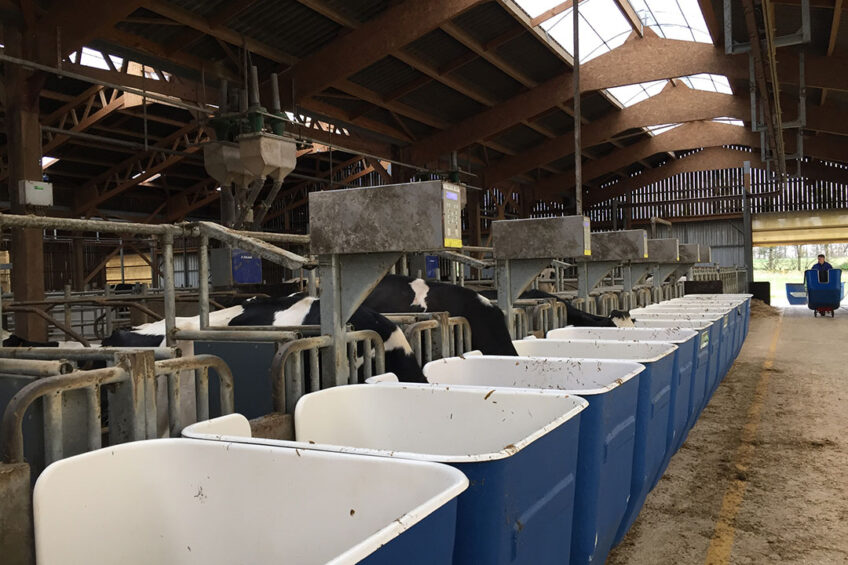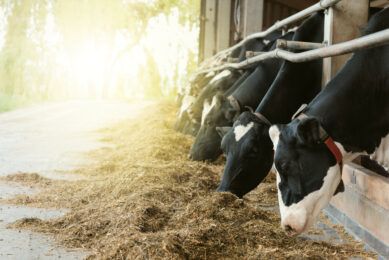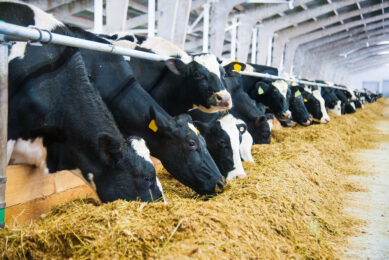MiXscience Research Center boosts cow nutrition research

With almost 300 trials per year and over 1,600 different animal diets tested, the MiXscience Research Center (MRC) is an important asset for companies to test and further improve their products and application. The ruminant research unit has been revamped, offering more potential to study dairy cow nutrition.
Animal diets or feed additives may look nice on paper, but it is all about how the feed and additives behave in real animals, kept under real farm conditions. Most of the feed companies therefore collaborate with external research farms or commercial farms to test the products in practice before they enter the market. The French animal nutrition company MiXscience, part of the Avril Group, has the luxury of owning its own research centre located in Pays de la Loire, a region in western France, consisting of 214 hectares of research facilities for cattle, poultry, pigs, rabbits and crops. The monogastric facility is shared with 2 other companies in a legal structure called Euronutrition. MiXscience does its own trials here, but can for example also collaborate on research programmes with the other 2 companies. The dairy facility is fully owned by MiXscience. In total, 55 people work at the MRC including 35 MiXscience researchers that are linked to these facilities for their work. The MRC has its own small feed plant with a capacity of 2,800 tonnes. Dairy Global caught up with Baptiste Lepauvre, head of communication at MRC to learn more about the facilities and what is being done regarding dairy cow research.

Focus on innovation
Around 60 years ago, the first trials began at the MRC by the Sanders Group, the compound animal feed business and part of the Avril Group. Since then, the focus has changed from doing ‘simple’ trials to conducting more and advanced trials, involving many studies with specialised products. “With the increased use of feed additives we also see more research in this area. More feed additives enter the market space and also more additives are used at the same time in one diet. It is therefore important to know how to make them work in the total feed matrix, without losing their characteristics and performance. In our research we focus on combining nutrition, techniques and formulation of new products to make them work better and more efficiently,” explains Mr Lepauvre. “But next to the technical and formulation challenges of products, we also strongly focus on increasing our knowledge of raw materials and product quality amongst others. Raw materials research delves into digestibility, palatability and nutritional quality of grains and forages. In addition, we look at new raw materials and protein sources that enter the world of animal feed, such as protein concentrates, insects and algae for example,” he added.
New high-tech cow facility
With almost 300 trials per year and over 1,600 different animal diets tested, MRC is one of the biggest research facilities in Europe. The premises consist of farms housing:
- 220 sows
- 6,000 piglets
- 1,500 fattening pigs
- 6,000 broiler birds (chicken and turkey)
- 1,200 layers
- 160 rabbit does
- 1,200 fattening places for rabbits
- 10,000 produced rabbits
- 120 bulls.

A new cow building with a capacity of 140 cows was built 3 years ago, giving the cow nutrition research a big boost. The research barn functions as a normal farm. The cows produce around 12,000kg milk per year with 4% fat and 3.3% protein. “We are very happy with the new barn, as this has everything we need to carry out advanced nutritional studies in cattle. The forage for the dairy cows comes from the farm’s own 35 ha maize and 30 ha grass. The farm has 2 milking robots, 12 robotic feeders and 80 individual trough. The dairy research unit makes it possible to carry out trials during different important stages of the cow’s life (lactation, dry and heifer stage),” he says. There are currently 120 dairy cows, of which 99 in lactation. In these animals, different raw materials, aromas, feed formulations and way of presenting the feed are tested. Also some cows have been selected for digestibility trials. Dairy nutrition research has become a very important part for MiXscience and about a third of all the activities at MRC are dairy cow based. 30 people are working in the ruminant department (not only research nor dairy). Mr Lepauvre: “The first year of the new cow facility was fully dedicated to teaching the cows how to use the automatic feeders and the milking system, as the old building was straw based, had a milking parlour and a classic feeding system.”
The filling up of the feeding troughs. Have a look at the video.
It all starts in the feed kitchen
The ability to feed the cows individually and to measure feed intake per cow adds a powerful experimental tool to the MiXscience research activities. The ear tag of the cow is linked with the amount of feed or type of diet she is assigned. Feeding of the cows starts in the feed kitchen, a room next to the barn with 30 big bags of feed pellets are connected to pipes, leading to the mixer wagon or directly to the 2 robotic feeders or robotic milking system. Big bags are used because it is a research farm where many different diets are tested. The big bags represent a total of 20-24 different feed formula. Outside the feed kitchen, the maize silage, grass silage and alfalfa are stored in feed bunks. Depending on the trial formulation, the feed pellets and raw materials are mixed in the feed mixers. This is done very accurate, with only 1kg maximum in dosing error for forage distribution and pellets are dosed with 1gr precision. The mixers are connected to the feeding wagons, that bring the feed to the cows. Between different diets, the pipes are cleaned when needed. “The largest part of the complete feed is sent to the automatic feeders. 2 of them are in the milking robot and 10 are situated around the milking robots. Each automatic feeders has 3 to 4 buckets attached to it, which means that per feeder also 3 to 4 different diets can be tested. The troughs and feeders open when the cow is still allowed to feed that day and when it is the right feed in the feeders for that specific cow. The amount of variety that this brings us, makes it possible to do a lot of feeding trials and to generate a lot of information. We have a specialised computer programme to manage it all,” he explains. All the individual feeders are calibrated every 2no weeks and regularly cleaned. All the trials run for an average of 12 weeks. Some trials take longer, some trials take only a few weeks. In between trials, the cows are also ‘calibrated’ so to say, during which they receive a basic feed for 3 weeks before a new trial begins.

Focus areas dairy cow research
The focus of the trials in dairy cows is on raw materials, feed additives, and other solutions of MiXscience’s portfolio. Examples of feed additives tested are mixtures of different essential oils, plant extracts and tannins. In dairy cow diets, these additives help to improve the efficiency of protein utilisation. “The use of these kinds of additives in ruminants is relatively new, so we want to understand the mode of action of these different products, the effects in the animal and the effect on performance. Another area of research is the protected vitamin B concept, tested in real animals but also in-vitro in the artificial rumen (see box).
The artificial rumen for product development
|
Precise feeding of cows, in terms of amino acid balancing and rumen microbiota also gets more attention these days. Furthermore, the behaviour of the animal around feeding is also a topic of interest. Knowing more about this can help feed advisors to adjust their advice regarding formulation and rations. Just like all the research in all animal species at MRC, the focus in dairy cows is also on sustainability and environment. According to Mr Lepauvre the overall aim of all research is adjusting the feed formulation to make sure that you get more milk, meat or eggs out of 1kg of feed makes the total farming system more efficient and more sustainable. Doing more with less. But also products that a farmer can use in times when milk prices are low are being developed, focused on better rumen degradability and better overall feed efficiency. “When milk prices are low and feed prices remain at the same level, the margins are under pressure. A farmer can choose to optimise the diet for least cost formulation to get more value from corn silage. This can be done by including certain feed additives in the formulation,” says Mr Lepauvre. The continuous focus on product development is reflected by new products for dairy cows that will be further rolled out and promoted in 2019. These include a premixture of additives, designed to enhance natural defences and at the same time support the respiratory comfort in young ruminants, a premixture of additives to reduce to consequences of exposure to parasitic risk and a combination of rumen by-pass microencapsulated additives to decrease fat induced liver malfunction. All of these products have been extensively tested at the MRC.
The datalab for more insights
The data collected in the feeding troughs, robotic feeders and the milking robot generate a wealth of information, such as feed consumption, time in the milking robot, protein intake, quantity and quality of the milk etc. Over 100 data points are gathered per cow per day, and to make sense of it all and to be able to see trends and even make prediction models, MRC has dedicated data analysts to do just that. These specialists are experts in data interpretation and support the research team in statistics and modelling of the research data. For the dairy research unit they developed a programme to be able to run the trials properly and to connect all the data gathered in the studies. But the development of this also led to the creation of a computer-based software called Canopée which is sold to farmers to monitor and evaluate cow performance. “Data management is important, because by adding more layers to certain data, you get new insights. If you know the feed intake and the milk production, we know the feed efficiency of the cows. But what if we couple these data with heat stress for example? This is where our data scientist can help us out, finding new correlations and being able to make models to better predict the health and performance of the animals,” he continues.
There is still a lot to gain
Considering that there is a MiXscience product mixed into 8.8 million tonnes of total feed per year and 1.75 million cattle per year eat a diet with one of the MiXscience additives in them, you can imagine that the French animal nutrition company has a big influence on animal production in many countries. Product development and research is therefore very important to be able to keep delivering products that are good for the animal, the farmer, the end consumer and the environment. “We know already quite a lot about poultry and pig nutrition, but there is a lot of knowledge to gain when it comes to dairy nutrition. The dairy sector is also changing a lot, reflected in bigger farms and less cows going to pasture. This means that the way we feed the cows is also changing. We are entering a stage in ruminant nutrition where it is all about precise nutrition, balancing nutrients and discovering more about which bacteria are present in the rumen and how we can influence these better. There is lots to discover and MRC, with its new dairy cow facility is an important part of this,” Mr Lepauvre concludes.
Join 13,000+ subscribers
Subscribe to our newsletter to stay updated about all the need-to-know content in the dairy sector, two times a week.


 The rumen is known to have a strong degradability of certain feed ingredients, such as vitamins. B vitamins for example are degraded to a great extent (95% for B9 and 78% for B5). This is why companies are developing rumen protected feed additives to make sure the active substances are released after the rumen. MiXscience has developed the VSTAR technology to encapsulate feed ingredients. For ruminants this is important to make the feed ingredients rumen protected. This technology has been applied to a mixture of B5, B6, B8, B9 and B12, known to be the most limiting B vitamins for cows. “A lot of scientific research on vitamin B for cows stems from the 1950s. However, dairy farming and the way we feed cows has changed considerably. Cows are producing more milk and forage or soy containing low concentrations of B vitamins. The high milk output, coupled with more intensive diets has increased the need for supplementation of B vitamins. In the last 10-20 years a lot of research on this topic has been done in Canada and the researchers showed that when you give B vitamins to cows you see strong and quick results. We are testing our rumen protected vitamin B blend now at European farms that use robotic milking, feeding high levels of concentrated feed and have a high milk production,” explains Justine Laisement, product manager for the ruminants in-feed solutions portfolio at MiXscience. But before the rumen protected products are tested in real animals, the company makes use of the artificial rumen, a machine that mimics a real rumen based on temperate, pH and liquid and solid passage rated. “You can use an artificial rumen where you only put the sole feed ingredient in, but there is also one where you can add the actual compound feed as well. Both of these systems gives us quick insights in to how the feed formulation is behaving in the rumen. It is therefore an important tool in our development of rumen protected products,” explains Ms Laisement. (Photo: The artificial rumen. Credit: Justine Laisement)
The rumen is known to have a strong degradability of certain feed ingredients, such as vitamins. B vitamins for example are degraded to a great extent (95% for B9 and 78% for B5). This is why companies are developing rumen protected feed additives to make sure the active substances are released after the rumen. MiXscience has developed the VSTAR technology to encapsulate feed ingredients. For ruminants this is important to make the feed ingredients rumen protected. This technology has been applied to a mixture of B5, B6, B8, B9 and B12, known to be the most limiting B vitamins for cows. “A lot of scientific research on vitamin B for cows stems from the 1950s. However, dairy farming and the way we feed cows has changed considerably. Cows are producing more milk and forage or soy containing low concentrations of B vitamins. The high milk output, coupled with more intensive diets has increased the need for supplementation of B vitamins. In the last 10-20 years a lot of research on this topic has been done in Canada and the researchers showed that when you give B vitamins to cows you see strong and quick results. We are testing our rumen protected vitamin B blend now at European farms that use robotic milking, feeding high levels of concentrated feed and have a high milk production,” explains Justine Laisement, product manager for the ruminants in-feed solutions portfolio at MiXscience. But before the rumen protected products are tested in real animals, the company makes use of the artificial rumen, a machine that mimics a real rumen based on temperate, pH and liquid and solid passage rated. “You can use an artificial rumen where you only put the sole feed ingredient in, but there is also one where you can add the actual compound feed as well. Both of these systems gives us quick insights in to how the feed formulation is behaving in the rumen. It is therefore an important tool in our development of rumen protected products,” explains Ms Laisement. (Photo: The artificial rumen. Credit: Justine Laisement)







